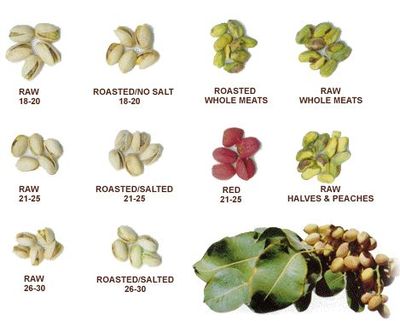Pistachios
The pistachio-tree looks like the almond-tree and the walnut-tree in some respects. If the pistachio-tree grows wild then it looks more like a shrub than a tree. The nut is covered by a thin hard shell that in its turn is covered by a soft fleshy hull.
While ripening he kernel gets bigger and thats why after some time the hard shell opens. These nuts are called splits. When the are not ripe we cal them non-splits. The nut grows in bunches on the tree, to compare with the growth of grapes.
There are male and female pistachio-trees. The pollen from the blossom of the male trees are blown by the wind to the female trees. The male tree bears no fruit, of course and its sole task is to pollinate the female tree. Pistachio-trees are two- years bearers, which means that they produce a harvest every other year. It takes six to seven years before a tree begins to bear fruits.
The harvesting is done by hand, after that the nuts are dried in the sun and are packed in a gunny sack. The "roasted" nuts are put in a water tank and sink to the bottom. After that the nuts are put in a salt solution and finally in an oven where the moisture evaporates during a roasting process lasting about 20 minutes.

Origin
Iran, Turkey, and USA (the last harvest with machines).
Graduations
Natural/roasted:
USA : 21-25 28-30
Iran/Turkey: 18-20 20-22 22-24 24-26 26-28 28-30 nuts per ounce (= 28 grams)
Packing : in boxes of 10 11,34 20 25 kg (roasted)
In bags of about 70 kg (natural)
User possibilities
As a snack (baked in oil or roasted); as ingredient (chopped) in ice; shelled as ingredient for various melanges and as garnish.
Harvest-times
October/November
Food-value per 100 grams:
| Energy | 659 kcal. |
|---|---|
| Protein | 19,9 g |
| Fat | 55,7 g |
| Koolhydrate | 17,7 g |
| Minerals | 2,8 g |
| Vitamin B | 0,67 mg |
| Other | 4,0 g |


